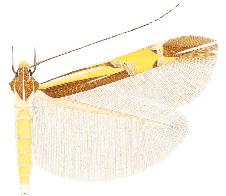
Adoxophyes is a genus of moths of the tribe Archipini.
Licigena is a monotypic genus of moths belonging to the subfamily Olethreutinae of the family Tortricidae. Its sole species is Licigena sertula, which has been found in Sri Lanka. Both the genus and species were first described by Alexey Diakonoff in 1982.

Cosmopterix carpo is a moth of the family Cosmopterigidae. It is known from Puerto Rico and the British Virgin Islands (Tortola).

Cosmopterix galapagosensis is a moth of the family Cosmopterigidae. It is known from the Galapagos Islands.

Cosmopterix madeleinae is a moth of the family Cosmopterigidae. It is known from the Galapagos Islands.

Adoxophyes templana is a species of moth of the family Tortricidae. It is found in Australia, but also on the Bismarck Archipelago.
Sparganothina aurozodion is a species of moth of the family Tortricidae. It is found in Peru.
Adoxophyes bematica is a species of moth of the family Tortricidae. It is found on the Solomon Islands to the east of Papua New Guinea.
Adoxophyes tripselia is a species of moth of the family Tortricidae. It is found in Australia, where it has been recorded from Queensland.
Adoxophyes panxantha is a species of moth of the family Tortricidae first described by Oswald Bertram Lower in 1901. It is found in Australia, where it has been recorded from Queensland.
Adoxophyes dubia is a species of moth of the family Tortricidae. It is found in Japan, where it has been recorded from southern Honshu, Shikoku, Kyushu and Okinawa.
Adoxophyes honmai, the summer fruit tortrix, is a species of moth of the family Tortricidae. It is found in Japan, where it has been recorded from Honshu and is possibly also present on Shikoku and Kyushu.
Adoxophyes fasciata is a species of moth of the family Tortricidae. It is found in Japan, Taiwan and China.
Adoxophyes furcatana is a species of moth of the family Tortricidae. It is found in eastern North America.

Adoxophyes negundana, the shimmering adoxophyes moth, is a species of moth of the family Tortricidae. It is found in North America, where it has been recorded from Ontario to Manitoba, south to Florida and west to Utah.
Archips eupatris is a species of moth of the family Tortricidae first described by Edward Meyrick in 1908. It is found in Sri Lanka.
Adoxophyes meion is a species of moth of the family Tortricidae first described by Józef Razowski in 2013. It is found on Seram Island in Indonesia. The habitat consists of secondary forests and dipterocarp forests.
Adoxophyes olethra is a species of moth of the family Tortricidae first described by Józef Razowski in 2013. It is found on Seram Island in Indonesia. The habitat consists of upper montane forests.
Adoxophyes parameca is a species of moth of the family Tortricidae first described by Józef Razowski in 2013. It is found on Seram Island in Indonesia. The habitat consists of upper montane forests.
Adoxophyes panurga is a species of moth of the family Tortricidae first described by Józef Razowski in 2013. It is found on Seram Island in Indonesia. The habitat consists of lower montane forests and alluvial forests.



